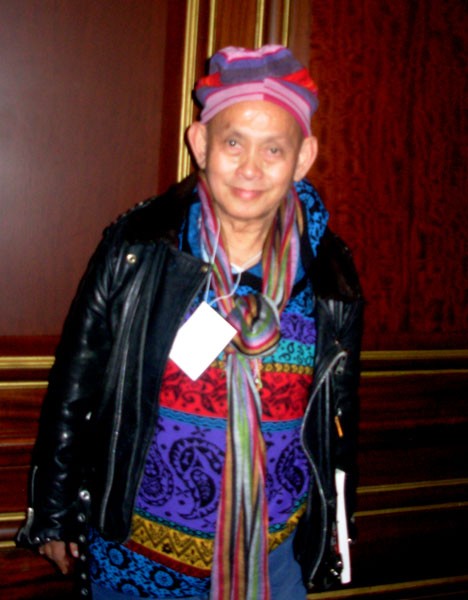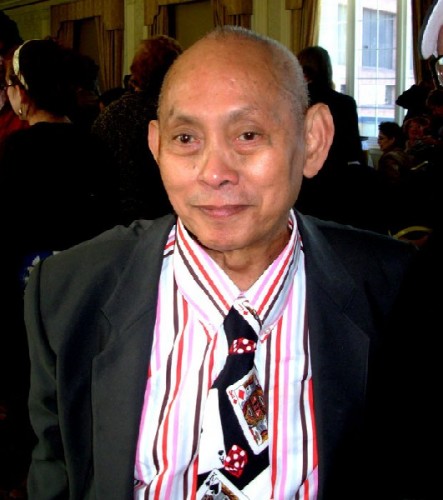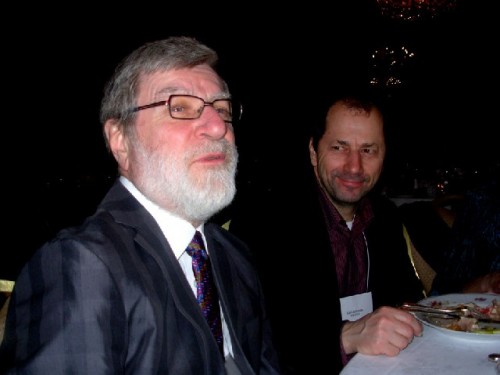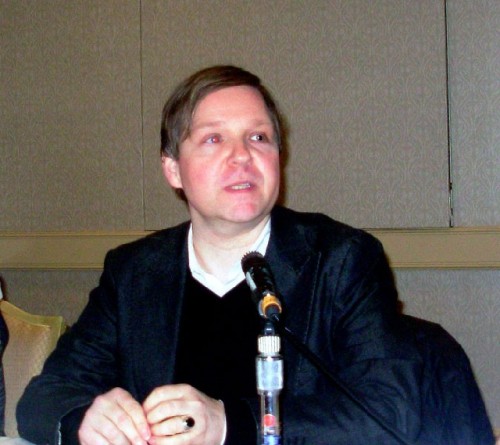2009 Conference International Opportunities for Artists
Part Two: The Session on Biennials
By: Charles Giuliano - Apr 09, 2009
The Venice Biennale was founded in 1895 as a kind of trade fair, with a number of permanent pavilions evoking nationalistic agendas through displays of visual culture. This was followed in longevity and prestige by the Sao Paulo Bienal in 1951, and Documenta, held every five years since 1955, in Kassel, Germany.
Over the past decade there has been a proliferation of biennials and triennials which number more than 200 globally. There may be even more if the proliferation of off the track city, and museum events are added to the mix.
Given this growth and global reach there is but a select inner circle of individuals- collectors, gallerists, curators, or artists with great curiosity and deep pockets- who are capable of keeping pace with even a generous sample of what is offered. Most of us follow this phenomenon indirectly, through art magazines and internet reports. We tend to pick and choose focusing on particular events. There may be a very specific motive for visiting that biennial in Shanghai, Istanbul, Johannesberg, Sydney, Dakar, Singapore, or Tierra del Fiego. It is more likely that with limited resources we splurge on a visit to Venice or Documenta. As the largest and most prestigious events they provide the greatest bang for the shrinking buck. During a week in Venice, for example, one just hemorrhages money.
When we do make the effort, like attending and covering the 2007 Venice Biennale, there is excitement, insight, and inspiration, as well as, frustration and disappointment. That said, what's not to like about being in Venice no matter the cost? There is the pure exotic delight of being in one of the most beautiful cities in the world with its great cultural and visual art traditions. If one is fed up slogging around the Arsenale and its inanities treat yourself to an afternoon in the Accademia or sip prosecco at your favorite little wine bar next to a neighborhood canal. Ah Venezia; the city of Titian and Thomas Mann.
Like the never ending art fairs is the proliferation of biennials yet another signifier of the excess of the past decade? Is it time now in the post Bernard Madoff era for sackcloth and ashes? Does the art world drag itself along the Via Dolorosa self flagellating in an act of contrition? Should we wear hair shirts to remind us of our sins?
Given the current state of the arts, and the biennials as a talking point, it was with special interest that we attended the session moderated by Mario Caro, the President of Res Artis and curator at New York City's Alaska House, on Sunday morning during the 2009 Conference International Opportunities for Artists. The speakers included Ute Meta Bauer, the visual arts chair at MIT, co-curator of Documenta 11, and director of the 3rd Berlin Biennial for Contemporary Art (2004). Joining her were the artist, David Medalla, founder and director of the London Biennale, Claude Gosselin, the director of the Montreal Biennale, which opens on May 1, and William Stover, the Assistant Curator of Contemporary Art of the Museum of Fine Arts Boston. Stover was a replacement for the architect Yung Ho Chang who was unable to participate.
Considering the enormous significance of the topic, and the expertise of those participating, this was, for me, the most anticipated session of the conference. It proved to be as lively, provocative, frustrating, and disappointing, as say, a visit to a biennial. In miniature, perhaps unintentionally, the session seemed to parallel and underscore the issues and conundrums of its broad topic. One came away with tasty morsels but hardly the satisfying full experience that was hoped for.
Primarily, this occurred because the puckish, charming, self absorbed, David Medalla, provided much of the humor and gonzo flavor of the session. But he then went on to undermine and sabotage the panel with constant and rambling interruptions. Specifically, he disrupted the attempt of Meta Bauer to present what promised to be a detailed and insightful report including an historic overview of biennials as well as a critical analysis of their current status. In this regard, Caro failed to function as a moderator by allowing Medalla to run the clock on the session limiting the chance of a wider dialogue. It is common courtesy that speakers are allowed to make their presentations. Followed by discussion. Ute, for her part, out of "respect" for the "artist" allowed the disruption to continue. Repeatedly. So she was also at fault by playing into Medalla's game and not holding her ground.
This was most unfortunate because the issues are so important. During the dinner, the night before, I had discussed biennials with my friend of many years, Claude Gosselin. Since 1998, he has been the director of the Biennale de Montreal. Before that, in 1983, he founded Centre international d'art contemporain de Montreal which from 1985 to 1996 produced Cent jours d'art contemporain de Montreal. Over the years we attended and reported on a number of these events.
Unlike Venice and Documenta which are staged on permanent sites the events presented by Gosselin have always been inventive, opportunistic and amazingly quixotic. There is no fixed agenda and the delight of visiting is to discovery how, yet again, he has pulled a rabbit out of the hat with charming and clever legerdemain. One time the event was staged in an enormous abandoned Molson Beer Factory, for another project, in a series of underground retail spaces, usually a rotation of "borrowed" facilities. This year Claude states that the Biennale will be installed in a school.
Some 25 years on there is the constant challenge of funding through thick and lean times. Right now, not surprisingly, it is very tough. But he is responding to the challenge with what may prove to be his most inventive and risky project. Where in the past he created a mix of roughly half Canadian and half international artists, this time, there is not the budget to create an ambitious international project. What the actual Biennale will look like is something of a mystery. Briefly, it will change and by the end of the month will look different than during the vernissage. If all goes well the public is invited to interact with and change the works in music, film/ video, and visual art. He discussed this year's project during the session extending an invitation to the audience to come to Montreal which is not that far away.
The miserable state of the economy is a factor in any discussion of contemporary art. William Stover started by remarking that he was invited at the last minute and really had nothing to do with biennials. Instead he described his department and its projects as a part of the enormous changes at the museum which is in the midst of renovation and construction designed by Lord Norman Foster. Fairly recently Stover's superior, Cheryl Brutvan, was removed from her position as Curator of Contemporary Art. Last week, the MFA announced some 30 layoffs and reported that the endowment has lost a third of its value in the past year. So it has fallen to Stover to endure a demanding period of transition and change.
He did not discuss any of these issues and used his time to describe inventive projects and interactions with artists. The concept is to invite artists for a residence during which they have broad access to the museum and its depth of collections. Having surveyed the museum they are then invited to make proposals. Under former curator, Trevor Fairbrother, this took the form of Brice Marden developing an exhibition combining his own work with those selected from the permanent collection. This formula of the "artist's eye" became common in museums. Stover describes wanting to evolve to a new level for such collaborations with artists. A current "intervention" entailed allowing an artist to create a busy, strident, sprawling wall piece in the corridor next to the café. The original concept of the architect I.M. Pei was that the area would be free of art and a place for the eye to rest as a bit of visual sorbet..
When I discussed Pei's concept, after the panel, Stover remarked that it is a luxury that is now outdated. That the wall piece using broad bands of black tape in curving patterns informs visitors of the presence of contemporary art. Presently there is very little space devoted to contemporary art. He informed me that the current Gund Gallery for special exhibitions will show contemporary work when the Foster plan is completed and that the café and current book store will be relocated as will be the Gund Gallery. The auditorium will remain in the Pei wing. This will in essence create a contemporary wing. Of course this has never been a strength of the MFA, which continued to falter under Brutvan, a less than inspired hire by Malcolm Rogers. By comparison, Stover is widely respected, but holds a junior rank in the council of chiefs and warlords that traditionally have ruled the museum.
During the initial phases of the presentation by Medalla the audience was completely charmed and seduced. Many of his off color remarks were delightful and hilarious. While many artists ask, how does one apply to a biennial, Medalla's London Biennale invites anyone interested to participate. It may not even be in London. The last one was originated in Paris and the next one will start in India. There was an opportunity to use a very large palace in India, not only as a site for the Biennale, but also as a crash pad for the participants. He informed us that he does not own a computer or cell phone. Also, he refused an offer of support from the Mayor of London. Sponsorship comes with censorship and control. Medalla is loosey goosey and improvisational to a fault. He appears to suffer a creative form of Tourette's Syndrome.
Compared to the concise presentations of Gosselin and Stover, that of Madella dragged on, however entertaining. Eventually, he ceded the microphone to Meta Bauer before reclaiming it again and again. Someone needed to give this imp and mischief maker a good spanking.
Meta Bauer attempted to offer an overview of why the Venice Biennale is obsolete, an expensive project beyond fixing, as well as, making a case for why we need all those far flung and marginal biennials. These were some of the same arguments that Gosselin had advanced the night before and I was keen to hear what Ute had to say as well as Claude having a chance to join the dialogue.
Why do we need all those biennials? During a power point presentation Meta Bauer projected a map of Southeast Asia. She discussed how connecting the dots some five biennials were due to open within six days. This evoked the practice of skipping from one biennial to another. Gosselin had described a recent visit to Europe that followed a similar strategy. One hops from Basel, to Venice, to Kassel, to Munster, to Berlin, to London. It starts to sound rather like a chess game. But Meta Bauer discussed the merits of going off track and out of the way. One is less likely to find the usual suspects of Festival Art that are unique to the biennial circuit. Often the more remote Third World projects have a different motive. This entails combining local and indigenous artists in dialogue with mainstream outsiders. Simultaneously, this showcases work being created in that region of the world and also exposes its community to outside resources and influences.
She discussed the Second Johannesberg Biennale which was curated by Okwui Enwezor prior to his appointment to develop Documenta 11. Since she collaborated with him it would have been insightful to hear her comments. But no, Madella interrupted to give his anecdote on Johannesburg. He described how a South African artist complained during the opening that the exhibition included artists from Milan to the exclusion of Africans. Madella told the artist that this was an opportunity to see the work of the artist from Milan without the expense of having to go there. "That's just masturbation" Madella reported was the angry response of the artist. "Don't you like to masturbate" Madella asked the artist who then left in a huff. Yes, amusing, but.
Meta Bauer tried to discuss how Venice has become so expensive that many of the major galleries which supported the Biennale are refusing to cooperate this time. This seems to contradict news reports that there will be pavilions by a record 77 nations in the Venice Biennale which opens in June. In an on line report in Art Net titled "The Recession Biennale," by Lavinia Filippi, there is an interview with the Frankfurt based curator, Daniel Birnbaum, the youngest every for Venice. His exhibition "Making Worlds" will include 90 artists with many Italians. This evolved from the hundreds of studio visits the curator made during a year of working in Italy on the Biennale. News reports indicate a very full and lively 2009 Venice Biennale including "In-finitum" the third and final cross-cultural extravaganza mounted in the Palazzo Fortuny. The second version was the absolute highlight of Venice in 2007. While she touched on some of the problems of Venice, she failed when asked, to discuss the issues and problems that Robert Storr encountered as the curator in 2007. Storr was attacked and then venomously responded in Art Forum. Meta Bauer appeared to be unwilling to take a position in that controvery.
Can Venice be saved or fixed? Meta Bauer does not appear to think so. Asked, if given the opportunity, how would you change Venice? Her response was "I wouldn't try." Certainly the relevance of those national pavilions is outdated. Many artists are ambivalent about waving the flag of their nation. There are issues when an artist is born in one nation but lives in another. This year, for example, the artist Lucas Samaras, who resides in New York, will represent Greece. Krzystof Wodiczko, a professor at MIT who has been included in a Whitney Biennial, will be shown in the Polish pavilion. But the national pavilions signify valuable cultural real estate that nobody appears ready to covert into condos. During our visit in 2007 some of those pavilions were relevant while many were not. But the Storr project had little or nothing to do with the pavilions nor will Birnbaum have any ability to change that archaic infrastructure. The best part of the 2007 Biennale was that it expanded all over Venice and during a visit of several days we were not able to track down everything that was on view. So, yes there are enormous problems, but nobody appears ready to pull the plug on Venice..
Turning to Sao Paulo Meta Bauer described a curatorial decision to leave an entire floor free of work. Like Pei's corridor at the MFA this was intended to allow "breathing room" for the dense Bienal. Artists loudly protested that this was a squandering of valuable space. Because Sao Paulo has traditionally been free it attracts a million visitors. It also appears to generate a lot of passion. Before she could set forth her arguments about this curatorial decision, yet again, Madella jumped in by informing us that he attended the Sao Paulo Bienal and defended the side of protesting artists.
Yes, one sees the point of the artists. It is always better to be included than excluded. But there is also a good case to be made for allowing open space and breathing room. During the process of installation projects benefit from what is removed. It is often a tough issue to convince artists not to clutter their exhibitions. Less is more. Basta.








